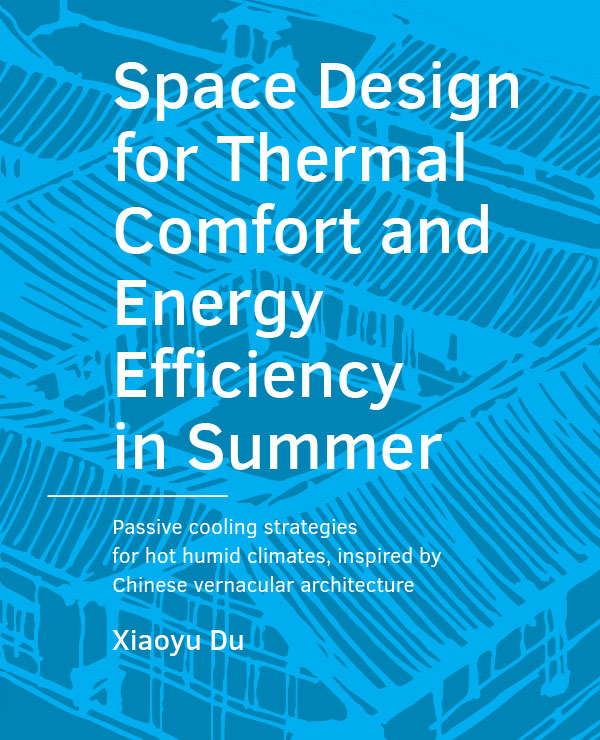Spatial configuration evaluation of Chinese rural houses through visual graph analysis for adaptive thermal comfort
DOI:
https://doi.org/10.7480/abe.19.10.4113Abstract
In chapter 9, it was found that the spatial indicators can reflect the airflow performance. There is a positive or linear correlation between the spatial indicators (connectivity, integration and depth) and the airflow indicator (airflow rate). The indicators that reflect the accessibility of the spatial configuration, i.e. connectivity, integration and depth, reflect the potential of achieving natural ventilation of a particular spatial configuration. In the other words, a high degree of connectivity, integration and low depth value mean a high accessibility of the spatial configuration and a high potential of obtaining natural ventilation. This result is useful for the architectural design practice, especially in the early design stage. In chapter 10, the extended space syntax methods in the program of Depthmap for natural ventilation potential analysis were proposed by the author. In this chapter 11, the proposed methods for spatial analysis will be used for design practice. The spatial configurations of a number of Chinese rural house designs in the area studied will be evaluated in terms of natural ventilation potential for thermal summer comfort by the proposed spatial analysis methods.
The rural houses as a case study in this research is chosen because the Chinese rural houses normally using passive ways to achieve thermal comfort in summer, therefore the spatial configuration for natural ventilation is important, as the author concluded in part 1 in this thesis. In addition, the rural population in China accounts for 40% of the total population with a total amount of approximately 560 million at the end of 2018 (NBSC, 2018). At the end of 2014, there were more than 585,451 villages in China and the rural housing area is at present 22.6 billion m², within a total area of more than 40 billion m² of China’s urban and rural housing together. The amount of rural housing is constantly rising. According to 2010 data, the total floor space of newly built houses is 1.6 billion m², and half of them are rural residential buildings (NBSC, 2018). Therefore, improving the living environment for Chinese rural residential buildings is important for the sustainable development of China. Moreover, previous studies have been carried out on the sustainable development of Chinese rural residential building. However, many investigations and studies related to energy conservation and indoor thermal comfort have been proposed for northern China’s rural houses (Jin & Zhou, 2008; Lai, Zhang, Wei, & Zhang, 2011; Sun, 2003; Yang, Yang, Yan, & Liu, 2011; Zhao & Jin, 2007; Zheng, Li, & Yang, 2008), focusing on winter comfort. Studies of the Chinese rural residential building in the hot humid climate regions are scarce (Han, Zhang, & Zhou, 2009; Jin, Meng, Zhao, Zhang, & Chen, 2013; Liu, Tan, Chen, Chu, & Zhang, 2013; Xie & Shi, 2012). Studies of spatial configuration for passive cooling of rural residential building design are very scarce.
References
CCC. (2011). General Atlas of Rural Housing Design in Chongqing Chongqing: Chongqing Construction Committee
Han, J., Zhang, G., & Zhou, J. (2009). Research on the rural residential thermal environment and thermal comfort in hot summer and cold winter climate zone. Journal of Hunan University (Natural Sciences), 36(6), 13-17.
Jin, H., & Zhou, C. (2008). Energy efficiency of combined solar collector for rural houses in cold areas. Journal of Harbin Institute of Technology, 40(12), 2007-2010.
Jin, L., Meng, Q., Zhao, L., Zhang, Y., & Chen, L. (2013). Indoor environment and thermal comfort in rural houses in east Guangdong of China. Journal of Civil. Architectural and Environmental Engineering, 35(2), 106-112.
Lai, Y., Zhang, Z., Wei, F., & Zhang, L. (2011). Comparative analysis on energy consumption of typical residence in rural areas of Northern China. Transactions of the CSAE, 27(1), 12-16. doi: 10.3969/j.issn.1002-6819.2011.z1.003
Liu, J., Tan, X., Chen, K., Chu, Y., & Zhang, H. (2013). The energy consumption simulation research of typcal roofing in rural residence at Zhouzhou city in Hunan province. Sichuan Building Science, 39(2), 360-362.
NBSC. (2018). Annual report (Publication no. http://data.stats.gov.cn/english/easyquery.htm?cn=C01). Available from National Bureau of Statistics of China National database, from National Bureau of Statistics of China
Sun, S. (2003). Energy saving and environment protection in rural of North China. Journal of Harbin Institute of Technology, 35(6), 763-765.
Xie, M., & Shi, L. (2012). Influence of vegetation around rural housing on natural ventilation in Hunan province. Journal of Hunan University (Natural Sciences), 39(7), 20-24.
Yang, L., Yang, Q., Yan, H., & Liu, J. (2011). Field study on thermal comfort of rural houses in winter in the Guangzhong region, Shanxi province. Journal of Xi’an Univ. of Arch. and Tech. :Natural Science Edition, 43(4), 551-556.
Zhao, H., & Jin, H. (2007). Research on the local optimum eco- technologies of rural housing in the chill region of China. Journal of Harbin Institute of Technology, 39(2), 235-237.
Zheng, Z., Li, Y., & Yang, X. (2008). Study on energy efficiency of rural residential building in Beijing. Building Science, 24(4), 9-14.


